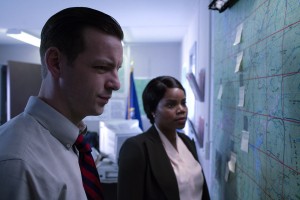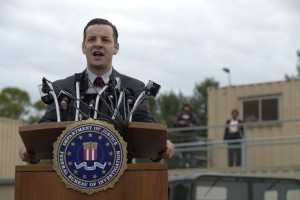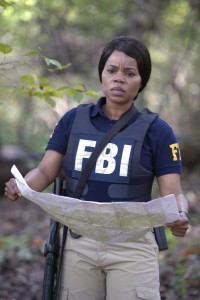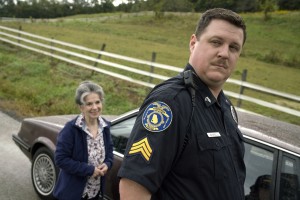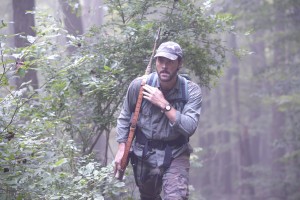MANHUNT: DEADLY GAMES, now available in its ten-episode entirety on Spectrum on Demand, is the second season of MANHUNT. Both seasons dramatize FBI searches for serial bombers. In 2017’s Season 1, the subtitle was UNABOMBER and the subject was Theodore J. Kaczynski, played by Paul Bettany. MANHUNT: DEADLY GAMES focuses on the mistaken investigation into Georgia security guard Richard Jewell (also dramatized in the recent film RICHARD JEWELL) for the bombing at the 1996 Olympics and the eventual, lengthy quest to capture the real bomber, Eric Rudolph.
Andrew Sodroski originally created MANHUNT with former FBI agent Jim Clemente and Tony Gittelson. The series was nominated for a Writers Guild of America award for long-form television. Sodroski adapted MANHUNT: DEADLY GAMES partially from Maryanne Vollers’s 2006 nonfiction book LONE WOLF: ERIC RUDOLPH.
Sodroski’s fellow MANHUNT executive producer Michael Dinner is also a director on the series. Dinner won an Emmy for Outstanding Directing for THE WONDER YEARS. Dinner’s other directing/producing credits include SNEAKY PETE, ELECTRIC DREAMS, JUSTIFIED, and THE MOB DOCTOR.
Sodroski and Dinner sit down together to discuss MANHUNT: DEADLY GAMES.
ASSIGNMENT X: The first season of MANHUNT was on Discovery. How did the show wind up moving to Spectrum?
ANDREW SODROSKI: MANHUNT premiered on Discovery and did pretty well for them, but they decided to get out of scripted television entirely, and just stick with reality TV. Lionsgate was our studio on the first season, and they really believed in the show, and so when Discovery went unscripted, they allowed Lionsgate to take it out, and to find a new home on Spectrum.
AX: Is it coincidental that both seasons are about bombers, or are you really attracted to stories about bombers?
[Both laugh.]
MICHAEL DINNER: [joking] He’s an ex-bomber.
SODROSKI: I know. It was not our intention to tell stories only about bombers. When we were shooting the first season, we shot in Atlanta. And so we were around Olympic Park all the time, and the story was just so compelling that, despite it being about another bomber, I had to tell it.
AX: Season 1 is set in the ‘80s, and Season 2 is in the ‘90s. Are you purposely going forward in time with the seasons, or is that just how it worked out?
SODROSKI: When we were shooting Season 1, there’s this scene in Janet Reno’s office where Janet Reno is standing over her desk, it’s 1996, and there are stacks of case files. It was the first World Trade Center bombing. It was the Unabomber. It was Centennial Park and Eric Rudolph. And there was a moment when all of us were looking at that and thinking, “Wow, there’s an anthology right there, ‘From the Case Files of Janet Reno’” [laughs].
AX: Did you read Maryanne Vollers’s book about Eric Rudolph and decide, “I want to do this,” or did you already know you wanted to do the story and then found the book?
SODROSKI: I was really excited to tell the Richard Jewell story, but Richard Jewell doesn’t have enough meat for an entire TV show. So it wasn’t until I read Maryanne Vollers’s book that I realized, “Oh, wow, there’s this whole manhunt, it went for years, it’s an amazing story, and nobody knows about it. No one’s ever heard what happened to Eric Rudolph when he was out in the woods.” And that’s when it became a show. We have these two halves. And Maryanne is an awesome journalist, and I went up to Montana, and she opened her archives, and I walked away with tens of thousands of pages of documents, all about every aspect of the case.
We also got access to the FBI’s interviews with a lot of these people, a lot of documents from the search, from the case, and yeah, we had a full-time researcher on it for a long time, just gathering material. There are court records that we were reading, there are transcriptions of the depositions that Kathy Scruggs gave, like in that scene where Richard and Kathy sit across from each other. We did a lot of research, and we pulled a lot of the things from the show really right from the factual records.
DINNER: And in the frenzy of the story, so much was public that it was really, at the beginning of that – someone asked the question, “What would it be like today with social media?” This was like the Stone Age of that.
AX: At what point, if any, were you aware of the Clint Eastwood RICHARD JEWELL film before it opened?
[Both laugh.]
SODROSKI: Well, the script had been around, but we assumed the movie was never going to get made, until –
DINNER: The casting. And all of a sudden, we were both dealing with the same kind of actors. So then it became real.
AX: Were you like, “Uh-oh,” or were you like, “Oh, it’ll be good promotion for us”?
SODROSKI: Well, I feel like it’s a win-win for us, because our show includes the Richard Jewell story, but it’s not only the Richard Jewell story. We’re telling this other, much bigger story, of the hunt for Eric Rudolph. It’s the largest fugitive manhunt in American history, and so this is something the movie can’t touch on, it doesn’t have time to. And we get to explore the whole huge scope of this story in a really fun and exciting way. But also, we have the time to go deeper into the Richard Jewell story itself, just by the nature of our format.
AX: A controversy with the film, MANHUNT touches on it as well, is the depiction of the real-life, late reporter Kathy Scruggs, played in the series by Carla Gugino. In the film, she’s shown as having sex with an FBI agent to get a story. In MANHUNT, she’s shown as having sex with an Atlanta cop, not necessarily to obtain a story, but he does give her a story. Is that verifiable?
SODROSKI: That’s right. It’s more complicated and it’s accurate. It’s truthful. Kathy Scruggs slept around with a lot of Atlanta cops. And when she was found dead, she was in bed with a cop. He was alive. He survived the night, I guess. But that’s part of who Kathy was, is that she had deep relationships with the Atlanta Police Department in all kinds of ways, and these things aren’t simple. It’s not about trading sex for a story. It is about cultivating relationships, and she did that, and that gets complicated. One of the nice things about having the time to tell the story that we have is that we can understand that Kathy can be an excellent reporter, can be really, really smart, can be really, really good at her job, and yet also, her life can be a mess. All of it cohabits within the same person.
DINNER: That’s what makes interesting characters. I didn’t see, I didn’t want to watch the Eastwood movie. But I assume, because it’s [the relatively limited length of a feature film], that her story has a shorthand to it, which makes her feel not quite as dimensional. We spend time with this character. We spend time with all these characters. It’s a big ensemble in this piece. There are a lot of characters that make mistakes in this story. It’s a story about heroes, and also victims. And everybody’s life was affected by what transpired. Hers was. So I think we spend more time with her, so we understand. If someone makes the wrong choices, at least let’s understand why they made the choices.
AX: For a long time in this season of MANHUNT, the FBI agents refuse to listen to evidence. It’s unusual in a series or even in a film to have main characters who are not the villains, but who are consistently wrong-headed. How is that to write and direct?
SODROSKI: Gethin [Anthony, who plays the composite character of FBI Special Agent Jack Brennan] and I had many conversations about this. In those cases, what you’re trying to do is to find out why, in the moment, is that character making that decision. And even though we objectively, from the outside, know, “Oh, God, this is so terrible, don’t do it,” we understand exactly why they’re doing what they’re doing, and why they’re making the decisions that they’re making, and it makes sense from their perspective.
DINNER: I think you’re right. The fact is that there are a lot of characters in the piece, not just the Federal agents, who made a wrong decision. What what we do is to try to feel what the characters are feeling and understand what they’re going through. No actor wants to look stupid. No character wants to look stupid. And as long as we understand the pressures that are upon them, and why the decisions are made, then they’re still protagonists. So I think that that’s important, that there would be a certain amount of truth in what they’re doing, and that we understand it.
SODROSKI: Nobody thinks they’re making a wrong decision in the moment they make a wrong decision. And so you have to always remember that, and make sure the character actually thinks they’re doing the right thing in the moment. What is so great about this drama, that has so many different characters and so many points of view being articulated, is that you have an audience that experiences it, and is [thinking], “No, don’t do it, don’t do it – oh, he’s doing it …” It’s so fun and so exciting and so real.
AX: Eric Rudolph spends years hiding in North Carolina’s Nantahala National Forest, which meant that production spent a lot of time outdoors. Were you going, “Oh, great, we get to spend all this time out in the woods and in caves,” or were you going, “Oh, no, we have to spend all this time out in the woods and in caves”?
DINNER: Certainly, the second part of the story, once we move onto the pursuit of Eric, he disappeared into the woods, and that’s an interesting story to me, that for years, he was in a way being harbored by the militia of North Carolina, and he disappeared into the hollers of North Carolina. So the woods aren’t just the woods. They’re a place where, it’s a million acres that he could disappear into. So it was a challenge – how do you execute this, and do a good job, and give it some scope? Because a tree is a tree. But I think the woods really had a character. The little town had a character. And so on one hand, it gives you a tremendous amount of opportunity, but when it’s about ninety degrees, and you’re worried about the ticks crawling up your socks or whatever, then you curse yourself for making that decision.
AX: Where did you shoot this season of MANHUNT?
DINNER: We shot in western Pennsylvania. Part of the story takes place in Georgia. It starts with the ’96 Olympic bombing. And then it moves into North Carolina. And oftentimes, you can’t do a road show. You can’t go from one location to another. So we had to find a location to service the whole story. A decade ago, I shot the pilot for JUSTIFIED thirty miles around the Horn, in Pittsburgh. And it was a pretty good double for Harlan, Kentucky. Because the coal seam really started around western Pennsylvania and just started heading southwest. And I really like it there. There are a lot of little towns, and bridges, and texture to the place. We could get in the woods, the woods look great there, and the little towns are fantastic.
AX: Nick Searcy plays the local sheriff near Nantahala in MANHUNT. Did you hire him because of your work with him on JUSTIFIED?
DINNER: Nick’s part of my repertory company. I try to take Nick wherever I go. I did three of the eight hours of UNBELIEVABLE, the Netflix show, and so I brought him to do a little small part. I have these dreams someday that, if I ever did a last movie, I would gather every actor I’ve ever worked with, and, “Let’s just do Robert Altman-style, let’s just go make a movie.” [JUSTIFIED star] Tim [Olyphant] and I still always text each other and talk, and we’re still wondering if there’s more life to JUSTIFIED.
AX: Let’s hope so. That was a great show.
DINNER: Thank you.
AX: In MANHUNT: DEADLY GAMES, the story is bifurcated, because you’ve got Richard Jewell, and then you’ve got Eric Rudolph, who’s played by Jack Huston. Even though they’re investigated by some of the same people, they never really come into contact with each other. What were your thoughts about what the balance should be?
SODROSKI: One of the great challenges of the story is finding out how to pace the two stories, and finding the places where they intertwine, and tell it in a way that keeps the tension in both stories going simultaneously.
DINNER: You kept Richard [onscreen], except for one episode. We kept checking in with him throughout the piece.
SODROSKI: Yeah. And really, it’s about finding out where the most juice in the story is, and how to intertwine all these different strands so that they come together in a satisfying way.
AX: The actor who plays Richard Jewell, Cameron Britton, gave an amazing, chilling performance on MINDHUNTER as real-life serial killer Ed Kemper. He’s totally different as Richard Jewell, but did you find him through MINDHUNTER?
DINNER: We started making a list up of actors – it came from John Papsidera, who’s the casting director – and I had some surgery, and when I was recovering from the surgery, I was on pain pills, binge-watching MINDHUNTER. And so we were thinking about actors to play Richard Jewell, and he was on our list. And when he came in, I think I said that he scared the hell out of me. But we were so taken with him in the room, because he’s this hulking guy, and he was scary as hell in that show, but he’s a complicated sweetheart. And we felt that was a really important characteristic for Richard, that he couldn’t just be a victim, he couldn’t just be weird, that we had to humanize him so we rooted for him. And he just has this innate quality that makes you want to hug him, and you really felt that they had done wrong by him.
AX: What were the most satisfying scenes to do, and what were the most challenging scenes to do?
DINNER: Well, to recreate the bombing, and recreate Olympic Park, on a TV schedule and budget is hard. I think the approach was correct, though. I think it’s pretty scary, and I think we were able to do it, but my approach was not so much the recreation of it as to be in Richard’s shoes, and to somehow put a human face on those who were injured. So instead of about thirty bodies that were tossed around, how can we see the one, two, or three people who were affected, and see the interchange between Richard and those victims? So I think that worked pretty well, but I think the challenge was really how to recreate that aspect of it, especially because we had to recreate Olympic Park. But I’m a weird combination of, I like to do character-driven material; as I’ve gotten older, I like blowing stuff up. So I can do a character piece, and I can blow stuff up. I’m like my kids [laughs]. There’s a big scale to the show, but there’s also the small, intimate stuff. The last half of this piece, especially the end, is extremely emotional. And it’s about all these characters, where they finally end up, and their relationships with the people around them. The last episode is really quiet, and yet I think it’s a killer.
SODROSKI: I will echo everything Michael said. I think figuring out how to do the Centennial Park explosion and where the emphasis should be, and how we tell that story, was really, really challenging. For me, the best moments as a writer in the show, the moments I love the most, are the moments when the two plotlines intersect. And especially, I love the scene when Kelly [Jenrette, who plays FBI Special Agent Stacey Knox] and Gethin are interrogating Cameron, and we see that Richard Jewell is telling one story, and they’re hearing another story. And that’s an amazing, amazing moment. And we get there because we have all these triangular relationships, all playing out live in front of us. Another moment like that is in Episode 9, when Gethin, at the head of a group of militia men, and Kelly, at the head of a group of FBI agents, almost coming to blows with each other. It’s wild, and it’s one of these moments that you could never have seen coming from the beginning of the show, and yet it encapsulates all the themes of the show, which is about finding unity and common purpose, based on the bedrock of truth.
AX: Kelly Jenrette said that, at the time MANHUNT: DEADLY GAMES takes place, only three percent of FBI agents were black, let alone black women. So did you just want to have more diversity in your cast?
SODROSKI: No, what this was, is about finding a way for her character to be even more of a fish out of water than she already is. The real FBI agent she’s based on is female, but the idea of having an African-American woman going out into the wilderness of North Carolina, and facing off with militia men is super-dramatic and super-exciting, and it raises the stakes for her, and it raises the stakes for the whole show by opening up even more of a gulf between the two sides.
DINNER: We didn’t make an issue of that, but certainly, this is about a very specific place in North Carolina where they took this guy [Rudolph] in as a fugitive hero, and realized that they were taken in by the guy, and then had to work with the FBI to find this monster. But there is something about the Federal agents went into this town like invading troops in Iraq, and to put an African-American woman in the middle of this place that was basically a very white town, with the militia that’s running the town, we don’t make a point of it, but certainly it says something.
AX: If there is more MANHUNT, will it always be FBI cases? Or is it just important that it’s a manhunt?
SODROSKI: I think what’s kind of the DNA of the show isn’t that it’s FBI. It’s more that these are cases that really have something to say about the world we live in today, and about our society today. Season 1 was an old FBI case, but it was about individuality, and society, and technology, the place of the individual in the system. Season 2 is about humility, and about empathy, and about whether America is a nation of tribes, or whether we can be united, whether we can be E Pluribus Unum and come together to defeat evil. And so what we’re trying to do, no matter what the case is – it’s not about who’s the hunter and who’s the hunted so much as about who are we, and how can we shed some light on who we are today as a people?
AX: So you’re looking for cases that would have a deeper theme?
SODROSKI: Exactly.
AX: And what would both of you most like people to know about MANHUNT: DEADLY GAMES?
DINNER: I think it’s a really exciting story, I think it’s a really interesting story, and I think it’s a really emotional story. And I think by the time you get through the ten hours, and live in the shoes of these characters, that you not only know the characters, but you feel like you’ve learned something about yourself.
SODROSKI: That’s good. I would tell people, this is not a story that you know. This isn’t the story that you think it is. It’s much bigger, it’s broader, it’s more relevant, it’s more exciting than you might imagine.
This interview was conducted during Spectrum Originals’s portion of the Winter 2020 Television Critics Association (TCA) press tour.
Related: Exclusive Interview with MANHUNT: DEADLY GAMES stars Gethin Anthony and Kelly Jenrette
Follow us on Twitter at ASSIGNMENT X
Like us on Facebook at ASSIGNMENT X
Article Source: Assignment X
Article: Exclusive Interview with MANHUNT: DEADLY GAMES creator Andrew Sodroski and Director Michael Dinner on Season 2
Related Posts:








